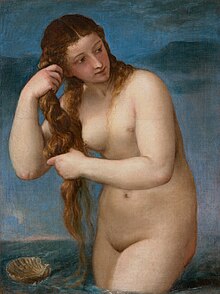Fertility in art

Fertility in art refers to any
Many civilisations in history believed in fertility
Traditional cultures

Fertility was present in art traditionally in many different forms. These include ceramic figures from some
Two of the earliest known possible depictions of fertility in art are the
Western art
Early forms

Modern
Paula Modersohn-Becker's series of self-portraits showing her pregnant even before she had actually been so represent her fertility.[9]
The shoe tied to the happy couple's car can be seen to represent the fertile vagina, as with The Old Woman Who Lived in a Shoe, a nursery rhyme.[10]
In
In
Literature
In The Bacchae, an ancient Greek tragedy written by Athenian playwright Euripides, Dionysus is mentioned as a male fertility god that represented a special kind of vitality that is sometimes referred to as the Life Force. It is described a force which, in itself, is neither good nor bad, but one that simply exists.[14]
When at the close of Possession: A Romance, a novel by A. S. Byatt, the two lovers Randolph Henry Ash and Christabel LaMotte finally unite in the midst of a great storm. They wake the next day to find that the whole world had a strange new smell. It is described as 'a green smell, a smell of shredded leaves and oozing resin, of crushed wood and splashed sap, a tart smell, which bore some relation to the smell of bitten apples.' It was the described as the smell of death and destruction, however, it was said to smell fresh, lively and hopeful.[15]
Notes
- ^ "Greek Goddess of the Earth". www.goddess-guide.com. Retrieved 2022-11-22.
- ^ a b "Laura Cumming on fertility in art and the birth of her twins". the Guardian. 2008-03-30. Retrieved 2022-11-22.
- ISBN 9781317598077– via Google Books.
- ^ Roberts, 747
- ^ Roberts, 140
- ^ "Venus Rising from the Sea ('Venus Anadyomene')". National Galleries of Scotland. Retrieved 2022-11-22.
- ^ C. G. Jung, Man and his Symbols (1964) p. 99
- ^ Roberts, 749
- ^ Roberts, 64
- ^ G. Legman, The Rationale of the Dirty Joke (1973) Vol II p. 90
- ^ Edmund Swinglehurts, Botticelli (1994) p. 26-7
- ^ John Golding, in D. H Kahnweiler et al eds., Picasso 1881/1973 (1973) p. 184
- ^ Golding, p. 115-6
- ^ Neil Curry trans., Euripides (Cambridge 1981) p. 164 and p. 116
- ^ A. S. Byatt, Possession: A Romance (1991) p. 507
See also
References
- Roberts, Helene E., Encyclopedia of Comparative Iconography: Themes Depicted in Works of Art, 2013, Routledge, ISBN 1136787933, 9781136787935, google books
Further reading
- James G. Frazer, The Golden Bough (1922)
- Roberts, Helene E., "Pregnancy" in Encyclopedia of Comparative Iconography: Themes Depicted in Works of Art, 2013, Routledge, ISBN 1136787933, 9781136787935, google books
- Jessie L. Weston, From Ritual to Romance (Cambridge)
